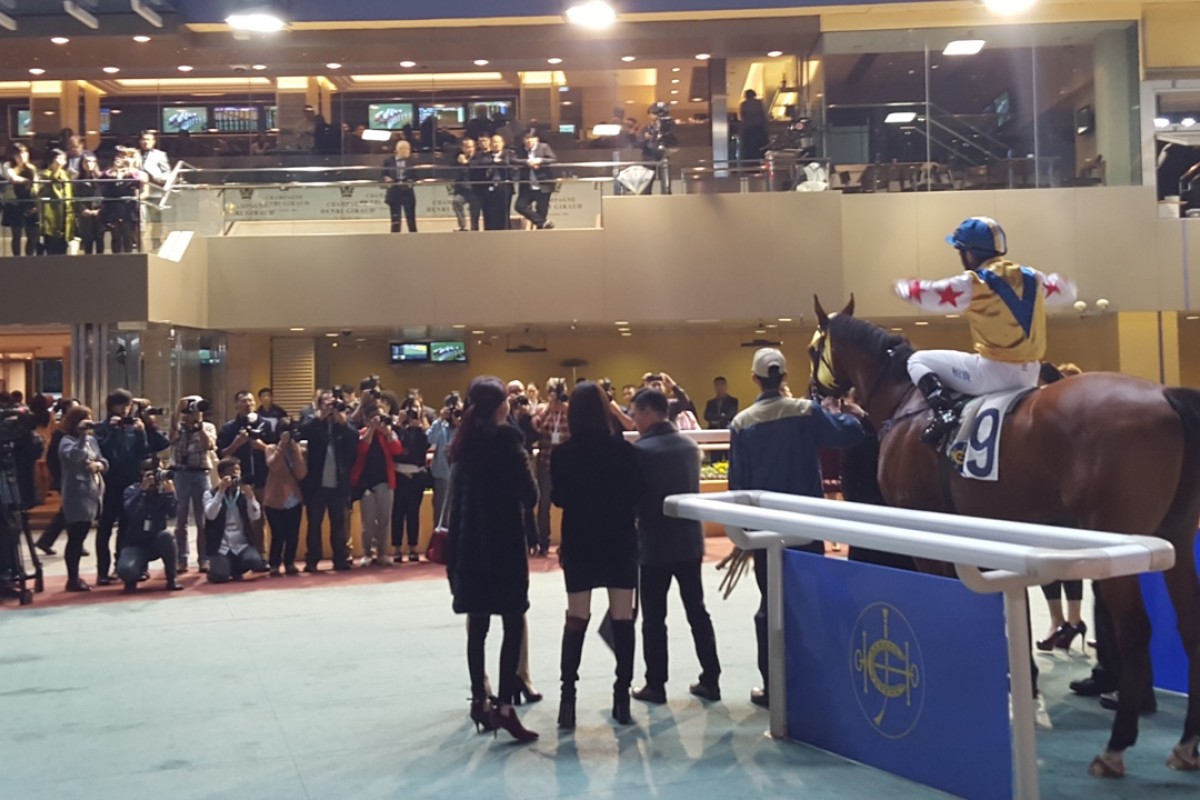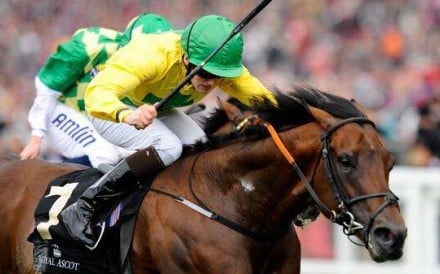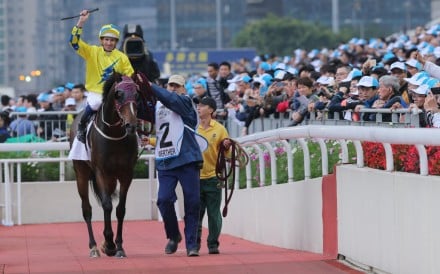There are many features of Hong Kong racing that make it unique, but one that is often overlooked is the multilingual aspect – and for the media, that creates an interesting landscape.
Hong Kong racing essentially operates in three languages – Cantonese, Putonghua (or Mandarin) and English. And while readers of the Post are obviously English speakers, it is Cantonese that dominates the racing scene. One recent estimate from a long-term local punter had turnover from English speakers at around 5 per cent of the HK$100 billion plus that is wagered on racing each season; Cantonese is closer to 90 per cent of that figure.
Obviously, the hope is that commingling will give a greater share to the English-speaking audience – and the Jockey Club has brought in respected operator George Irvine to boost the commingling product – but Cantonese will always be number one.
That split also extends to the racing media locally. Incredibly, there are 22 print publications in Hong Kong that have racing desks, or at least reporters assigned to horse racing. A whopping 21 of them are in Cantonese, with just one – the South China Morning Post – in English. And that’s just print – take into account form guides, television shows, radio spots and advertising, and the Cantonese market share clearly dominates.
Thought I'd spotted another Canto celeb, but better than that, it's Ben So - says he will be back at work next week pic.twitter.com/DsgZtRPzGD
— Michael Cox (@KemblaCoxy) February 10, 2016
Take Carlos Wu, the leading local presenter who commands one of the largest audiences for a racing journalist on the planet. And to many, his word is gospel, yet outside Hong Kong he is hardly known.
But Hong Kong is a fairly sterile place, at least as far as drama and news in racing is concerned – there is the odd moment of excitement, the rare hard news story, but on a day-to-day basis not a great deal happens, certainly not enough to sustain 21 full racing desks. Somehow, though, they find enough material.
This led us to thinking – what fills their pages? What keeps all their journalists employed? What do they focus on?
In a recent quiet moment in the small, somewhat dank media room opposite the winning post at Sha Tin, we asked a number of prominent local journalists, what were some of the recent highlights in the Cantonese media?
Some of the answers were rather surprising, especially for someone more used to a western approach to journalism and news – and this is from a small sample size, too. Go back beyond the last couple of weeks, and there are apparently some great stories.
For now though, here were four highlights from the last couple of weeks.
31 RACES IN NINE DAYS IS TOO MUCH
This is a common complaint amongst local journalists, and one which Wu in particular has written about many times before. It came up again during the recent Lunar New Year holiday, when there were 10 races on February 6, 11 races on the public holiday meeting on February 10 and 10 races on February 14.
Apparently, this was unacceptable. Far too much racing in too small a time period.
For those who have come through the Australian system, where they race all bar two days a year – Good Friday and Christmas Day – it seemed an odd complaint. How would they be suited in the United States, for instance, where individual tracks tend to have 10-race cards four times a week?
 Love was in the air at the Valentine’s Day meeting, but some were unhappy as it marked the third Sha Tin card in eight days.
Love was in the air at the Valentine’s Day meeting, but some were unhappy as it marked the third Sha Tin card in eight days.
Granted, field sizes are generally larger, races are more competitive and more work is required on a race-by-race basis, but still, to complain about workload seems a touch rich.
Ask any punter elsewhere, and they will say that one of Hong Kong’s best assets is the rarity of the product, with an average of 18 races a week – 28, if you use the formula employed by the locals. Ask any jockey, and the limited race schedule is a positive, not a negative.
The only complaints are coming from the media.
THE WORKLOAD ON JOURNALISTS IS TOO GREAT
This is in the same vein as too much racing, but one which never ceases to amaze. The amount of complaining about how tough life is for a racing journalist is something to behold. Trackwork hours are too long. There’s not enough time from declarations to the race. There’s a lack of information. (Yes, that was seriously an issue.)
Indeed, a number of columnists seem to take every opportunity to complain about how hard their job is, how they have it so tough, and how the reader should feel incredibly sorry for them.
 Michael Chang was satisfied with trackwork arrangements at Meydan last year, but not all journalists followed suit.
Michael Chang was satisfied with trackwork arrangements at Meydan last year, but not all journalists followed suit.
One columnist wrote a long critique of the Dubai Racing Club following the World Cup meeting last year. The complaint? That the only sustenance most mornings at trackwork for the media was coffee and biscuits. This was 離譜– outrageous! Amazingly, that piece attracted more views than the top five SCMP racing stories combined in 2015.
It is quite extraordinary, and yet these columns receive wide readership. It seems the Hong Kong punting public really does care for the plight of long-suffering journalists.
ATTRACTIVE RANDOM STRANGERS
Many of the racing reporters would be classified entertainment reporters elsewhere, while a lot of the photographers would be considered paparazzi.
That means that the personal lives of jockeys and trainers are a big focus, and they are treated like celebrities. Poor Vincent Cheminaud was confronted with this reality when he was grilled about whether he was single at a press conference before he started his stint – the 21-year-old is married and the father of a young son, much to the disappointment of the gathered media group.
If an attractive stranger turns up at trackwork – whoa, watch out. Their face will be plastered over every racing news site by the time the last horse has stepped off the track. It happened in recent weeks with a blonde girl who turned up out of the blue – it turned out to be Chad Schofield’s girlfriend Hannah Butler.
Schofields about to duel in R5: @SchofieldGlyn on Dancing Flames v @SchofieldChad on Lean Journey ... pic.twitter.com/xx3Pb1Tjkz
— Michael Cox (@KemblaCoxy) February 14, 2016
But this is a common occurrence.
Take a Dutch friend who turned up in town. She made her maiden appearance at trackwork on a Tuesday morning, and within an hour she was the talk of the town – so much so that she was interrupted frequently at Happy Valley the following night.
It happened again when one-time Miss Connecticut Acacia Courtney arrived in Hong Kong as part of the Jockey Club’s social media team for the international races. She received so much coverage that she was stopped in Lan Kwai Fong by a man who had downloaded a picture from one of the websites and made it his new phone screensaver. Creepy.
That time @acacia_courtney was approached by a man in LKF that had her picture as his screen saver 📸 #HKIR pic.twitter.com/La8qBFPkVM
— victoria garofalo (@itsmevictoriag) December 14, 2015
HOW DOES JOAO MOREIRA TAKE HIS COFFEE?
The question that sparked a war between rival publications recently: how does the Magic Man take his morning coffee? Perhaps linking Moreira and his coffee to Popeye and his spinach, trying to find the secret answer
It was a splash given the same amount of attention as some other famous headlines: think Dewey Defeats Truman (Chicago Daily Tribune), or Gotcha (The Sun), or something along those lines.
It was THE story of the century, or so it seemed. The answer? Well, we’re not really sure, but one thing that did come out of it was a heap of photos of a blurry-eyed Moreira in the Sha Tin trainer’s stand before trackwork.
Even champions need that kick.
Story of the season by ODN - Joao Moreira makes coffee in trainers' stand https://t.co/L1CjRv97iA pic.twitter.com/b5lAkOGbjw
— Michael Cox (@KemblaCoxy) January 22, 2016





















